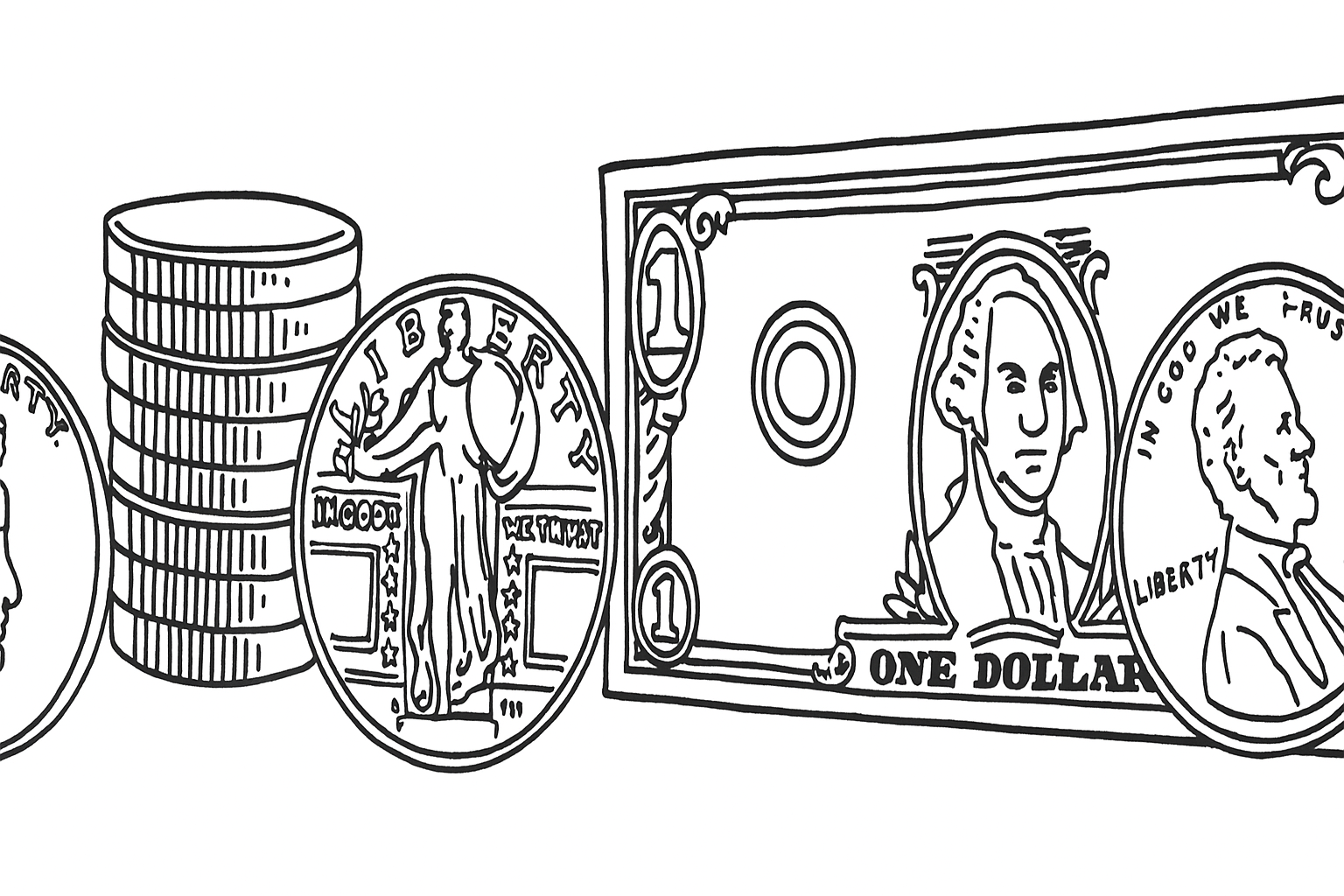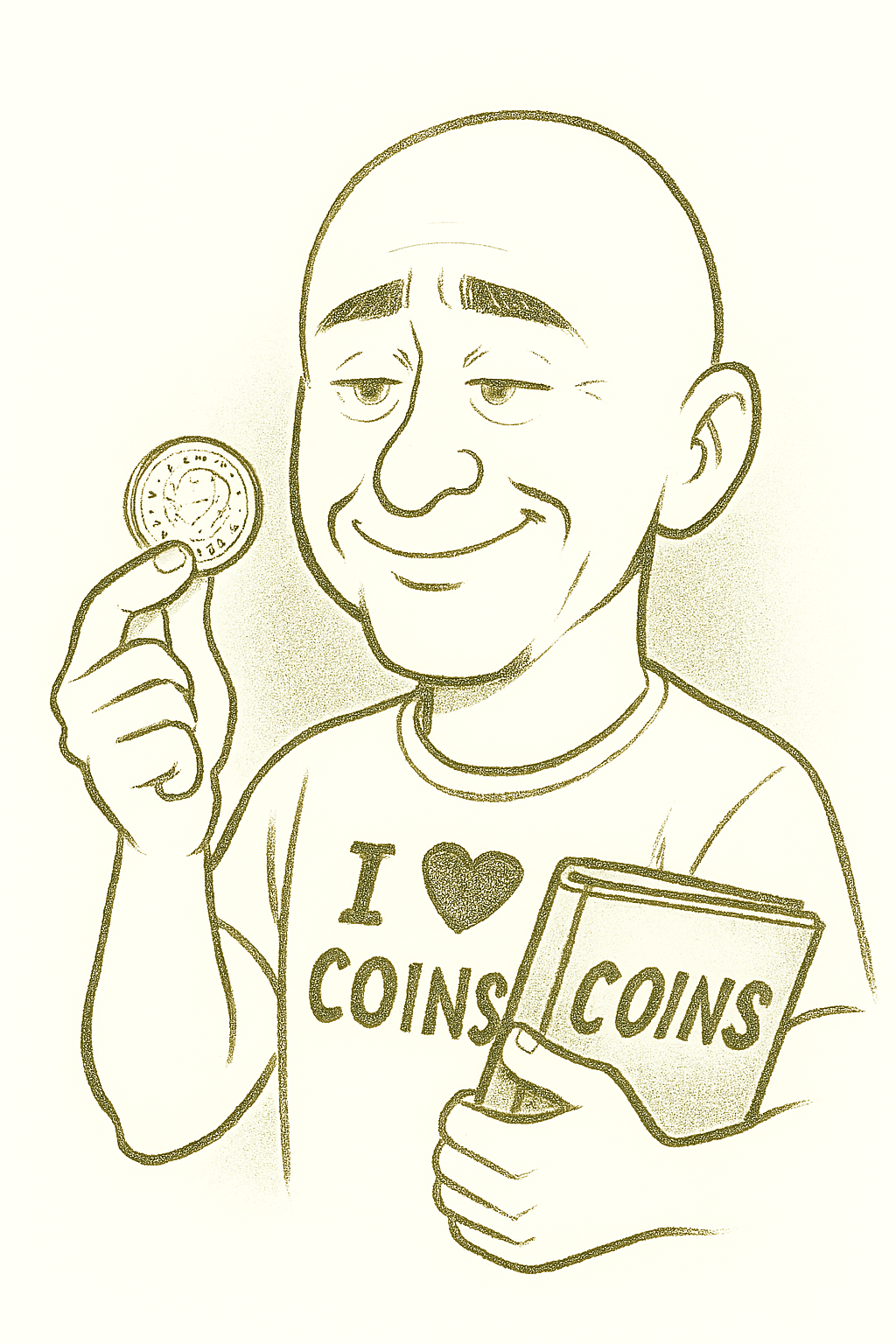
What is Numismatics?
Numismatics is the study and collection of coins, paper currency, tokens, and medals—items that have served as money or symbols of value throughout history. While these are the most familiar examples, the field also includes other financial instruments and objects tied to economic exchange, such as stock certificates, checks, and promissory notes.
People are drawn to numismatics for many reasons: its connection to history, its artistic appeal, and its insight into the evolution of trade and commerce. Certain items may also gain worth beyond their face value due to rarity, demand, or cultural significance.
Coin collecting remains the most well-known aspect of the hobby and is often used interchangeably with numismatics as a whole. However, the field encompasses far more, with countless areas of specialization that invite exploration, study, and discovery. Whether pursued for scholarship or enjoyment, numismatics opens a window into the story of human civilization through the money it has used.
That all being said, I just collect coins -- I am not a professional, but I do enjoy them and I enjoy the stories that go along with them...Are you familiar with the term "Just Joshin Ya" -- turns out that this is has to do with coins --
Back in 1883, the United States Mint rolled out a brand-new five-cent piece, called the Liberty Head nickel. It was shiny, gold-colored when new, and on the back was a big Roman numeral “V” for five. Trouble was, nowhere on that coin did it say the word “cents.”
Now, a few sharp-eyed folks noticed that this new nickel looked an awful lot like a five-dollar gold piece if you added a little polish and a thin layer of gold plating. Before long, some of these gilded nickels began turning up in shops across the country.
That’s where the story of Josh Tatum begins—or so folks say.
Josh, they tell us, was a young man who couldn’t hear or speak, but he wasn’t short on brains. One day, he got his hands on a few of those fresh 1883 nickels, gave them a golden sheen, and set out to test an idea.
He’d walk into a store, buy a cheap item—maybe a cigar or a newspaper—and hand over his gold-plated nickel. Being unable to talk, Josh never said a word. The shopkeeper, thinking he’d just been given a five-dollar gold piece, would count out $4.95 in change and send Josh on his way with a smile.
Josh never argued, never claimed the coin was gold. He just nodded politely, pocketed his change, and went about his business.
Before long, word spread of the quiet fellow making a tidy sum with his “gold” nickels. Eventually, the law caught up with him, and Josh was hauled before the court on charges of fraud.
But here’s the twist that keeps his
name alive—according to the legend, the judge found Josh not guilty.
The reasoning? He never actually said
anything false. He didn’t speak at all! The court supposedly decided
that while others had been fooled, Josh hadn’t broken the law.
Folks say that from that day on, whenever someone played a harmless trick or pulled your leg, they’d grin and say, “Aw, don’t get mad—I’m just Joshin’ ya!”
Truth or Tall Tale?
Now, historians will tell you that’s mostly folklore. No record of a real Josh Tatum ever turned up, and the phrase “to josh”—meaning to kid or tease—was already in print before that shiny Liberty nickel ever saw the light of day.
But as any good storyteller knows, sometimes a legend lasts longer than the truth. The tale of Josh Tatum, the man who never lied but fooled them all the same, is still told wherever old coins and tall tales meet.
So the next time someone hands you a nickel and a smile, remember old Josh—and check the coin before you give back too much change.
Determining the Value of Your Coins
People often begin their numismatic
journey with a simple question: “What
are my coins worth?”
Unfortunately, the answer isn’t as simple as looking up a number
online. The value of a coin depends on more than its age or design —
it must be examined to confirm whether it’s genuine, what condition
it’s in, and whether it has been damaged or altered.
Ultimately, a coin’s value is what someone is willing to pay for it. Collectors and dealers weigh several factors before settling on a fair price.
Key Factors That Determine a Coin’s Worth
1.
Identification
The first step is knowing exactly what you have. Determine the country
that issued the coin, its denomination (face value), date, and
mintmark (if one exists).
Some years feature more than one design — those variations matter. If
your piece lacks a denomination entirely, it might not be a coin at
all but rather a token
or medal.
2.
Authenticity
Counterfeiting and altered coins have existed for centuries. For rare
or valuable pieces, a professional authentication is essential. An
expert can tell whether your coin is genuine or an imitation.
3.
Grade (Condition)
A coin’s grade describes
its overall preservation, from heavily worn to pristine mint state.
Prices can vary dramatically between grades — even a small difference
in wear can mean hundreds or thousands of dollars for some coins.
4.
Damage and Alteration
Collectors prefer coins that have never been cleaned, polished, or
tampered with. Damage such as corrosion, holes, deep scratches, or
bent edges reduces desirability and price. These are sometimes called
problem coins and typically
sell for much less than undamaged examples.
While grade and condition may not affect the price of common coins with little collector interest, they are crucial for coins sought by numismatists.
Using Price Guides
After identifying and grading your coin, consult a price guide to estimate its market range. Here are some of the best-known references:
-
The Standard Catalog of World Coins by Krause & Mishler — four volumes covering coins from 1601 through 2000. They have not published a new book in a few years.
-
The Red Book (A Guide Book of United States Coins) — an annually updated retail guide filled with history and pricing.
-
Coin World, Coin Prices, and Coin Age — regularly published periodicals offering up-to-date U.S. coin values.
-
The Greysheet (Coin Dealer Newsletter) — used by dealers to establish wholesale prices; related versions include the Bluesheet (sight-unseen certified prices) and Greensheet (for paper money).
-
The Blue Book (A Handbook of United States Coins) — commonly used by dealers when buying coins from the public.
-
Numismatic News — publishes both dealer and retail value listings.
These publications can be found in coin shops, bookstores, libraries, and online.
For digital resources:
-
NumisMedia offers online price guides for U.S. coins (values typically reflect high retail).
Frequently Asked Coin Values
Circulated U.S. Wheat Cents (1909–1958)
Most wheat pennies from 1940 and later are bought in bulk for under
2¢ each.
Earlier issues, especially from the 1910s
and 1920s, can be worth several cents to a few dollars
depending on rarity and condition.
1943 “Steel Pennies”
During World War II, cents were
struck from zinc-coated steel instead of bronze. Over one billion were made, so most are common —
worth around 5¢ to 50¢
in circulated condition, and slightly more if uncirculated.
If you find a bronze-colored 1943 cent, test it with a magnet: if it
sticks, it’s a copper-plated steel novelty; if it doesn’t, it could be
a rare bronze planchet error, potentially worth thousands.
Silver Dimes, Quarters, and Half Dollars (1964 and earlier)
These coins are 90% silver and contain about 0.715 oz of silver per $1 face value.
With silver at $51.24 per
ounce, $100 in face value equals roughly $3,662 in melt value (51.24 × 0.715 × 100).
Half dollars dated 1965–1970 are 40% silver, giving them a smaller but still significant bullion value.
Certain dates, mint marks, and collector demand can bring a premium above bullion value, so check a price guide for specific coins.
Silver Dollars (1935 and earlier)
Each coin contains about 0.77 oz of silver. Even common dates usually sell above melt value. Rare dates and higher grades can command much more, so consult a guide for valuations.
Susan B. Anthony Dollars (1979–1981, 1999)
Circulated examples are worth $1.
Proofs or uncirculated coins can be worth a few dollars, but most in
change remain at face value.
Sacagawea and Native American Dollars (2000–present)
-
Sacagawea dollar: First issued in 2000; primarily used in circulation early on, now mainly produced for proof sets and collector rolls.
-
Native American $1 Coin Program (2009–present): Annual reverse design changes honoring Native American contributions.
-
Circulated examples usually remain $1, but proof or uncirculated coins may be worth several dollars depending on condition and collector interest.
Bicentennial Coins (1976 Quarters, Halves, Dollars)
Billions were made, so most remain at face value.
-
Rolls of lightly circulated coins may fetch a small premium.
-
Special 40% silver collector issues (solid silver edge) are worth more for bullion content.
State Quarters (1999–2008)
-
50 designs representing each state.
-
Circulation coins are worth face value, though uncirculated rolls or high-grade examples may have modest premiums ($1–$3 per coin).
-
Silver proof sets and 90% silver collector versions hold significant bullion value.
Presidential Dollars (2007–2016)
-
4 designs per year honoring U.S. presidents in order of office.
-
Circulated coins are worth $1.
-
Proof sets, uncirculated rolls, and collector-only silver editions carry extra value.
America the Beautiful Quarters (2010–2021)
-
Annual program featuring national parks and sites.
-
Circulated coins are 25¢, collector coins in silver or proof condition carry higher value.
Modern Lincoln Cents (2009–present)
-
2009: Four designs depicting Lincoln’s life.
-
2010–present: Reverse features the Union Shield; special collector sets exist each year.
-
Circulated coins are face value, proof and uncirculated coins may have minor premiums.
Special Mint Issues (Collector Coins, Proofs, Commemoratives)
The U.S. Mint produces coins not intended for circulation every year:
-
Proof sets, uncirculated sets, and commemorative coins
-
Often sold in silver, clad, or gold compositions
-
Values vary by metal content, mintage, and collector demand
-
These coins are not found in everyday circulation but are highly sought by collectors.
Prince Charles & Princess Diana Commemorative Coins (1981)
Tens of millions were issued across Commonwealth nations. Typical market prices range from $5–$25 depending on condition and country.
Two-Headed or Double-Tailed Coins
Most are novelties or magician’s
coins, created by hollowing out and combining two pieces.
These have no collector value.
However, genuine mules —
coins struck with mismatched dies — are extremely rare. Known examples
include:
-
An 1869 Indian cent struck with two obverse dies.
A 1993-D Lincoln cent with a Roosevelt dime reverse.
A 1995 Lincoln cent with a Roosevelt dime reverse.
A 1999 Lincoln cent with a Roosevelt dime reverse.
A 2000-P Sacagawea dollar with a Washington quarter obverse.
A 2000 Lincoln cent struck on a Sacagawea dollar planchet.
A 2000-P Sacagawea dollar struck on a Susan B. Anthony dollar planchet.
A 2001-D Lincoln cent with a Roosevelt dime reverse.
A 2014-D Sacagawea dollar with a Presidential dollar reverse.
If your coin appears similar and has no visible seam even under magnification, have it authenticated. Genuine mules are best sold through reputable auction houses.
Unstruck Blanks or Planchets
These are coin blanks that escaped the minting press. Most sell for a few dollars.
Misstruck or Error Coins
Minor striking flaws like small die cracks add little value. More dramatic errors, such as off-center strikes or clipped planchets, typically fetch a few to several dozen dollars. Major or visually striking mint errors can sell for hundreds. Always confirm authenticity before assuming rarity.
Final Thoughts
Determining a coin’s value blends research, observation, and experience. Use trusted guides, seek expert opinions, and avoid cleaning or altering your coins. Whether your find is a common penny or a once-in-a-lifetime rarity, knowledge is the most valuable tool in your collection.


